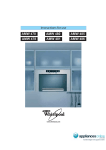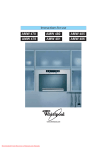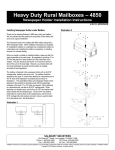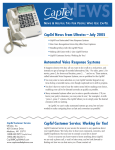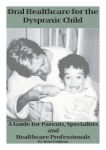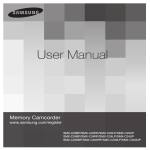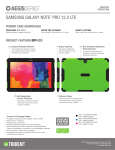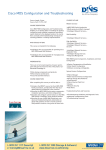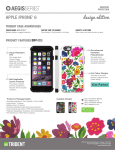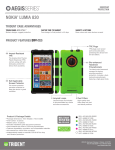Download City of Nanaimo Green Bin User Guide
Transcript
G REEN BIN UIDE WELCOME TO THE GREEN BIN PROGRAM Green bin food and kitchen waste collection is the most significant expansion of curbside services since the introduction of curbside recycling. Resident participation reduces the amount of waste going to the landfill by nearly 50 percent and uses the food waste collected to produce a valueadded product. The Green Bin Program provides weekly scheduled collection of food waste and compostable paper. More than 52,000 households region-wide are served by the program. MOVE BEYOND COMPOSTING CHECK YOUR CURBSIDE COLLECTION SCHEDULE Read the legend at the bottom of the schedule. Food and kitchen waste is scheduled for weekly collection (all coloured squares). The program goes beyond what can be composted at home by accepting cooked food, meat, fish, bones and food soiled paper and paper packaging such as waxed fast food cups and milk cartons. Instead of going to the landfill, compostable household organic material is converted into value-added resources – compost, nutrient-enriched soil, and eventually renewable fuels. One standard-size 77-litre container of garbage is scheduled for collection every two weeks (red square). Up to two additional containers can be put out on your collection day, by attaching a $2 tag to each additional standard-size container. Participating is as easy as following the simple steps in this guide. Your efforts will help achieve our regional goal of diverting 75 percent of waste from the landfill, and leading the way in BC and Canada. Recyclables are scheduled for collection once every two weeks (blue square). GETTING STARTED... Some schedules have a round symbol that is half blue and half red. This means garbage, food waste, and recycling will be collected on the same day. This results from extended periods between garbage pick-ups caused by statutory holidays. To use your green bin: 1. Read this guide and keep it handy for future reference. See the back page for a handy list of materials accepted in the green bin and the blue and yellow curbside recycling bags. 2. Check and follow your City of Nanaimo curbside collection schedule for green bin, garbage and recycling collection days. If you have questions regarding your schedule or collection, call Public Works at 250.758.5222. 3. Mark your green bin with your address to identify it with your home. This will reduce the risk of theft and cost of replacement. Visit www.nanaimo.ca or www.beyondcomposting.ca for more information or to view a short video that explains how to make the Green Bin Program work for you. The back of the collection schedule contains a variety of garbage, recycling and food waste related information. Visit www.nanaimo.ca for more information including access to a printable garbage, recycling and green bin collection schedule for all properties the City services. G REEN BIN BASICS In Your Kitchen Most households typically use a container similar to the one shown on the right or a plastic ice cream pail to collect their food waste in their kitchen. 1. Store your kitchen container on your counter, under the sink or other handy location. Do not put out for curbside collection. 2. Collect food waste in your kitchen container and empty when full into the large green bin. 3. Wash or rinse as needed. ON YOUR COLLECTION DAY One Truck, Two Compartments Lining Your Containers For convenience and cleanliness you may choose to use a liner in your kitchen container or green bin. The use of liner bags is optional but only compostable bags or products can be used. Here is some information that may be helpful: If you buy liner bags you will have to ensure the bag used has the certified “Compostable” logo. Plastic, biodegradable or oxy-degradable bags are not accepted. Approved compostable bags designed to breakdown in a composting facility are sold at most major grocery and hardware stores and other retailers throughout the region. Bags must have one of the symbols shown on the right on them. To help absorb moisture and keep materials from sticking, place crumpled newspaper, a paper bag or paper towels at the bottom of your green bin or kitchen container. If you choose not to use a liner bag, you can wrap food waste in newspaper or use paper food bags, cereal boxes (plastic liner removed) or a paper milk carton (plastic spout removed) to collect food scraps. This, along with frequent rinsing, will help keep containers clean. Using Your Green Bin 1. Use your green bin to store food waste. Place large soiled compostable paper products, such as waxed cardboard or pizza boxes directly in the green bin. 2. Keep the lid securely latched to help control odours and keep out rodents and other animals. 3. Store your green bin in a cool, ventilated location, such as where you keep your garbage can. 4. Place your green bin at the curb before 8 a.m. on your collection day even if it is not full. Please don’t use or place plastic bags, biodegradable bags or put any plastics glass, metal or Tetr , a Pak containers in yo ur green bin as this will cont aminate the compo st that is produced. Vehicles with two compartments will be used on scheduled garbage and food waste collection days. These “split-packer” trucks have two compartments to ensure the separation of materials. Using one truck to collect two materials at the same time will result in less vehicle emissions and no additional labour requirements for the Green Bin Program. Contaminants such as plastic, metal and glass affect the quality of compost and reduce its value. Green bins containing unacceptable items will be tagged and not collected. You will be responsible for removing these items from your bin. Your bin could be left behind if it contains unacceptable items. H ELPFUL HINTS... Preventing Odours Some materials in the green bin or kitchen container may cause slight odours just as they would if placed in your garbage. Here are some tips to help prevent odours: Empty your kitchen container frequently by transferring contents to your green bin and keep container lid tightly closed. Wash your kitchen container and green bin with hot water and bio-degradable detergent. To absorb moisture, line the bottom of your containers with newspaper, a paper bag or paper towel. Avoiding Conflicts with Wildlife Store your green bin in a secure location and ensure the lid is latched. Put your green bin at the curb on the morning of your collection day. Don’t leave it out overnight. Sprinkle your food waste with garden lime. This reduces odours that might attract wildlife. Use a spray bottle filled with a bleach solution to deodorize the lid and exterior of your green bin to prevent food odours from attracting wildlife. Freeze meat, fish, poultry or bones and put in your green bin on your collection day. Sprinkle a small amount of baking soda, garden lime or vinegar in your containers. Store your green bin in a secure, cool, ventilated location. Put your green bin out for collection every week even if it is not full. C ONTINUE BACKYARD COMPOSTING Please continue to compost suitable materials in your backyard composting bin. Yard and garden waste is not accepted in food waste containers. Home composting is the most cost-effective and environmentally friendly way to recycle these materials and produce a beneficial soil supplement for your yard and garden. You will want to use your green bin for meat and fish scraps, food-soiled paper products, bread and other items that aren’t suitable for backyard composting. E ND PRODUCTS - COMPOST & MORE Collection vehicles take material from your green bin to the International Composting Group (ICC) facility at Duke Point. Here food waste is mixed with other organic material, including ground-up yard and garden waste, using a recipe to balance carbon and nitrogen and produce the best compost product. At ICC, materials are composted using an aerobic, in-vessel process that generates sufficient heat to eliminate pathogens. Methane, a potent green house gas, is not produced. The compost produced meets the BC Organic Matter Recycling Regulation and is used by landscapers, farmers and gardeners. ICC is experimenting with producing renewable fuels from organic waste. Bulk and packaged compost and compost-enriched soil produced from the Green Bin Program can be purchased at Alpine’s Nanaimo Soil Mart, 2250 McGarrigle Road, Nanaimo. For more information, call 250.751.1089 or visit www.alpinesupersoil.com CITY OF NANAIMO CURBSIDE RECYCLING AND GREEN BIN GUIDE INSIDE YOUR GREEN BIN INSIDE YOUR YELLOW BAG Food Waste Including: Baked goods Baking Ingredients, herbs, spices Bones Bread, cereal, grains Candy Coffee grounds, filters, tea bags Dairy products, bu er, mayonnaise Egg shells Fruit and vegetable scraps Meat, fish/seafood, poultry Nuts and shells Pasta, rice Soiled Paper/Paper Packaging: Cardboard (including waxed) Ice cream, milk and cream cartons Gable top juice and soy milk cartons (plas removed) Paper cups and plates Paper fast food packaging Paper food packaging (unlined) Paper tow Pizza boxes Waxed paper Other: Compostable bags (must have compostable logo) Houseplants, cut and dried flowers Please Check: Household Paper Including: Including: Plas everage containers (may be returned for refund) Plas condiment bo ketchup, relish, mayonnaise, etc. o, Plas cosme hair rinses, etc. Plas ry detergent bo Plas food containers: margarine, yogurt, peanut bu er, etc. Plas Plas c vitamin bo les: pill bo les, mouth wash, etc. Please Check: Containers are rinsed (no food or other residue) NO foam plas rofoam NO containers that held chlorine or ammonia-based products NO motor oil containers NO metal bo caps, spray nozzle heads and metal a achments NO film plastic wrap (i.e. Saran Wrap) or bags, including grocery bags or bread bags NO plas etal or Styrofoam NO biodegradable, oxy-degradable or plas NO drink boxes or Tetra Pak containers NO yard and garden waste, feminine hygiene products, pet feces or cat li er NO diapers, baby wipes or dental floss vaccum bags and contents Boxboard packaging (cereal, detergent, soap boxes, shoe boxes, etc.) Catalogues Envelopes Fibre egg cartons Magazines Office Paper Paper Bags Telephone Directories Please Check: Paper is clean and dry (soiled paper can go in the Green Bin) NO hardcover books, soiled paper, drink boxes or paper with waxed s foil lamina coa towels, waxed paper, baking/parchment or soiled pizza boxes. (Soiled or waxed paper products can go in the Green Bin.) Metal Containers: Food and beverage cans and lids Foil containers and trays Please Check: Clean (NO food or other residue) Labels removed NO metal pots, plas laminated with foil such as chip bags or foil yogurt covers INSIDE YOUR BLUE BAG BESIDE YOUR BLUE & YELLOW BAG Newspapers Including: Flyers and inserts Please Check: NO books or soiled newspapers Cardboard: Fla ened (1 M x 1 M max. dimensions and NO waxed or coated boxes or non-corrugated boxes Waxed cardboard or boxboard can go in the Green Bin; non-corrugated cardboard (boxboard) can go in the Yellow Bag Thank you for participating! Using your green bin and maximizing your curbside recycling service will help you stay within the basic service that provides one container of garbage collected every other week. For questions about the Green Bin Program, or to replace lost, stolen or damaged containers, report missed pick-ups or request replacement schedules, call City of Nanaimo Public Works at 250.758.5222. Please recycle this newsletter. www.nanaimo.ca




